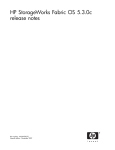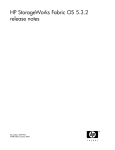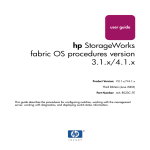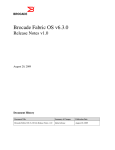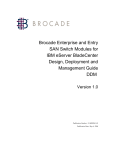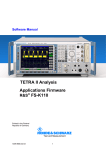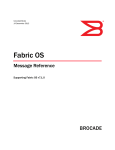Download HP StorageWorks Fabric OS 5.0.5d release notes
Transcript
HP StorageWorks Fabric OS 5.0.5d release notes Part number: AA-RW1WF-TE Sixth edition: July 2007 Legal and notice information © Copyright 2007 Hewlett-Packard Development Company, L.P. © Copyright 2004-2007 Brocade Communications Systems, Incorporated The information contained herein is subject to change without notice. The only warranties for HP products and services are set forth in the express warranty statements accompanying such products and services. Nothing herein should be construed as constituting an additional warranty. HP shall not be liable for technical or editorial errors or omissions contained herein. Microsoft and Windows are U.S. registered trademarks of Microsoft Corporation. Version: 5.0.5d Description Fabric OS 5.0.5d contains improvements since the release of Fabric OS 5.0.5c. Aside from these updates, this release includes the same feature set as Fabric OS 5.0.5. The previously released Fabric OS 5.0.5a included support for one new platform, the Brocade 4Gb SAN Switch for HP c-Class BladeSystem. NOTE: Maintenance releases Fabric OS 5.0.3 and 5.0.4 preceded this firmware release. Please note, HP never released and does not support Fabric OS 5.0.4. Update recommendation HP strongly recommends that users upgrade to Fabric OS 5.0.5d as soon as possible. Supersedes Fabric OS 5.0.5c released in February, 2007. Effective date July, 2007 Product models Fabric OS 5.0.5d firmware is supported on the following switches only. • HP StorageWorks Core Switch 2/64 (SilkWorm 12000) and HP StorageWorks SAN Director 2/128 in Chassis Config modes 3 and 4 only. Devices supported See the HP StorageWorks SAN design reference guide for supported devices: http://h18000.www1.hp.com/products/storageworks/san/documentation.html. HP StorageWorks Fabric OS 5.0.5d release notes 3 Prerequisites and requirements Table 1 summarizes current products running Fabric OS 5.0.5d firmware. The table lists the earliest recommended software versions. However, HP recommends using the latest supported software release versions to get the most benefit from the SAN. Table 1 Current supported Fabric OS versions Model Earliest version Recommended version Brocade 4Gb SAN Switch for HP c-Class BladeSystem 5.0.5 5.3.0 Brocade 4Gb SAN Switch for HP p-Class BladeSystem 5.0.0 5.3.0 HP StorageWorks Core Switch 2/64 4.1.0 5.0.5d HP StorageWorks SAN Director 2/128 4.2.0 5.0.5d1 15.0.5d is for Chassis Config modes 3 and 4 only for the 2/128. For a list of retired products, visit the following HP website: http://h18004.www1.hp.com/storage/retiredproducts.html?jumpid=reg_R1002_USEN Firmware upgrade instructions To access the latest Fabric OS 5.0.5d firmware, configuration files and MIB files go to the following HP website: http://www.hp.com/go/san Navigate to the appropriate product under the B-Series Switches section. IMPORTANT: HP does not support upgrading from more than two previous releases. Documentation This release of Fabric OS is supported by the Fabric OS 5.0.1 documentation set. Access the most recent Fabric OS 5.0.1 documentation: http://www.hp.com/go/san 4 Fabric OS 5.0.x support and interoperability Fabric OS 5.1.0 and later will not be supported on the HP StorageWorks Core Switch 2/64. The HP StorageWorks Core Switch 2/64 CPU and memory size are limited in their capacities to accommodate the new firmware. Attempting to download Fabric OS 5.1.0 or later firmware to a Core Switch 2/64 model results in a “Firmwaredownload failed” error. Fabric OS 5.1.x is not supported on the Brocade 4Gb SAN Switch for HP p-Class BladeSystem, or the Brocade 4Gb SAN Switch for HP c-Class BladeSystems. These switches have moved to the 5.2.1b or later Fabric OS. Operating systems See http://www.hp.com/go/san for a list of supported operating systems. Languages English Switch serial numbers Identify serial numbers as follows: • Brocade 4Gb SAN Switch for HP p-Class BladeSystem: Located on side of switch module. • Brocade 4Gb SAN Switch for HP c-Class BladeSystem: Located on bottom of switch module. • HP StorageWorks Core Switch 2/64: Located on inside front of the chassis, on the wall to the left of the ports. HP StorageWorks Fabric OS 5.0.5d release notes 5 Enhancements This section describes enhancements. tsTimeZone command The Energy Policy Act of 2005 changed the time change dates for Daylight Saving Time (DST) in the US. Beginning in 2007, DST will begin on the second Sunday of March and end the first Sunday of November. A new time was added to the zone format to allow you to set up time zones by region; DST is then automatically adjusted. The tsTimeZone command is used to display or set the time zone as follows: • tstimezone [hourOffset [, minuteOffset]] hourOffset (optional) — Specify the number of hours relative to GMT; must be an integer. Valid values are -12 through 12. minuteOffset (optional) — Specify the number of minutes relative to the hourOffset value; must be an integer. Valid values are -30, 0, or 30. The hourOffset can be specified without a minuteOffset, which then defaults to zero. • tstimezone — <timezonename> zonename — The name of the zoneinfo time zone; will vary as additional time zones are added. For example, to display the current time zone setup, then change them to GMT-3:30: switch:admin> tsTimeZone Time Zone Hour Offset: 0 Time Zone Minute Offset: 0 switch:admin> tsTimeZone -3, -30 Updating Time Zone configuration...done. System Time Zone change will take effect at next reboot. switch:admin> tsTimeZone Time Zone Hour Offset: -3 Time Zone Minute Offset: -30 6 Security-related enhancement A new role-based access control role, switch administrator, allows an administrator to control a switch but not modify any fabric-wide configuration, that is, security, zoning, or user configuration (see the userConfig command). Merging zones Before linking two switches together, it is important to know the zone database limit of adjacent switches. For details, refer to the section “Merging Zones,” in the Fabric OS Administrator’s Guide. Important notes The following sections list important notes. Obtaining a PKI Certificate for Secure Fabric OS For information on activating Secure Fabric OS go to the following HP website: http://www.hp.com/storage/go/secureos Also, you may refer to the Secure Fabric OS Administrator’s Guide, Chapter 2, “Preparing the Fabric for Secure Fabric OS,” for specific procedures. Non-default operands The use of non-default operands for diagnostic commands is recommended for advanced users and field support only. Need to turn traps on manually The SilkWorm and FA traps in pre-Fabric OS 4.4.0 code were turned on and off as a group; and it wasn’t possible to set individual SilkWorm or FA traps. In 4.4.0 the ability to turn traps on and off individually was added. That means that individual traps need to be turned on explicitly after the corresponding trap group is turned on. After the upgrade from Fabric OS 4.2.0 firmware, individual traps are turned off by default even if the corresponding trap group was turned on before the upgrade. Therefore, if you have been previously monitoring these traps, you need to use either snmpMibCapSet or the newer snmpconfig command to turn the desired traps on individually. The default setting is for all traps is Disabled. Zoning With AUDIT logging enabled, while performing zoning changes through the CLI, an additional audit log from HTTP may also appear along with the audit logs from zoning. This message does not always appear, and when it does, it represents redundant reporting by the CAL layer. Fabric Manager firmware download For an embedded switch running Fabric OS 5.0.2 and 5.0.3 using the small firmware file format, Fabric Manager (FM) version 5.0 supports firmware download using the external ftp server to download the firmware to the switch. In Fabric Manager’s Options dialog, set the FTP server setting to the external option. In the Firmware Download dialog, select the external ftp server to download. Fabric Manager does not support importing the image into the Fabric Manager firmware repository. HP StorageWorks Fabric OS 5.0.5d release notes 7 FICON/CUP support HP does not support IBM Fibre Connections (FICON) in this Fabric OS 5.0.5d firmware release. See http://www.hp.com for a list of currently supported features. NPIV update HP does not currently support N-Port ID Virtualization (NPIV) in this Fabric OS 5.0.5d firmware release. See http://www.hp.com for a list of currently supported features. Unsupported commands The slotOff and slotOn commands are now obsolete; use slotPowerOff and slotPowerOn instead. The portLogPortShow command is also now obsolete. RSCN suppression This release of Fabric OS features RSCN suppression: the ability to control RSCNs originating from hosts on a port-by-port basis. Enhanced RAS log messages New with Fabric OS 5.0.1 are Zoning Audit messages. These messages record information about the type of zoning change made (including such tasks as cfgenable and cfgdisable) and the role level and user name making the changes. The messages are recorded in the RASlog whether change was made through the CLI or Web Tools. Note that occasional redundant entries are possible due to an extra HTTP entry when zoning changes are performed through the CLI. Fabric scalability Fabric OS 5.0.5d supports the same fabric scalability as Fabric OS 4.4.0: 2,650 ports with 50 domains. Problem determination Fabric OS 5.0.5d features the fcPing command, which provides the ability to check Fibre Channel connectivity between any two nodes in a fabric. Fabric OS 5.0.5a fixes Table 2 lists improvements included in Fabric OS 5.0.5a. Table 2 Fabric OS 5.0.5a closed defects Closed Defects Host cannot see a specific device on 2Gb platforms: SAN Switch 2/32, Core Switch 2/64, SAN Director 2/128. The workaround if not upgrading to this latest 5.0.5a release is to remove and reinsert the cable, or run portDisable/portEnable. In rare cases, the zoning daemon (zoned) caused the switch to panic during HAfailover. An abrupt power failure on a port blade on a 4/256 SAN Director caused the CPs to sometimes fail. In the event of an abrupt power failure, the fix allows a small delay for the power failure to be reflected in the power status register. Revised the error message that displays when portCfgGPort is issued for embedded switches. 8 Fabric OS 5.0.5b fixes Table 3 lists improvements included in Fabric OS 5.0.5b. Table 3 Fabric OS 5.0.5b closed defects Closed Defects Inserting unsupported FC4-48 blade into a pre-Fabric OS 5.2 chassis causes FAULTY(1) error that will not clear with blade removal. HAsync is dropped, and an active CP reboot is required to recover. If not upgrading to this Fabric OS 5.0.5b release the workaround is to schedule a convenient time to reboot the active CP. HBA occasionally may not log into a 4Gb switch during auto topology discovery. If not upgrading to this Fabric OS 5.0.5b release the workaround is to use portCfgGPort to lock the switch in G port mode. To reestablish the link on the affected port, issue portDisable and portEnable. Switch panics with Failure Detection (FDET) when a Linux host is connected, affecting the SAN Switch 2/32, SAN Director 2/128, SAN Switch 2/8V and SAN Switch 2/16V platforms. A phantom device on an L-port disappears after HAfailover/hareboot, and a private device is no longer in the name server database, affecting the SAN Switch 2/32, Core Switch 2/64, SAN Director 2/128, SAN Switch 2/8V and SAN Switch 2/16V platforms. If not upgrading to this Fabric OS 5.0.5b release the workaround is to issue the portdisable and portenable commands. Specific HBA behavior causes a memory leak and the switch runs out of memory and reboots. Switch panics with time service daemon (tsd) core dump. Zoning change fails with message: unabortable internal zoning transaction. Zoning change fails with message: unabortable internal zoning transaction. The Web Tools GUI hangs upon invoking fabricwide polling when there is no IP connection between the Web Tools proxy switch and the other switches in the fabric. Without displaying an error message, a hardware ASIC failure causes performance degradation on a 4/256 SAN Director, or a switch fault on other 4Gb switches. If not upgrading to this Fabric OS 5.0.5b release the workaround is to replace the faulted blade. During stress testing, after fastboot on a fully-loaded 4/256 SAN Director a few E_ports and F_ports may stay in "Mod_Val" mode. If not upgrading to this Fabric OS 5.0.5b release the workaround is to disable and enable the port that is stuck in the Mod-Val state. During 3rd party SFP qualification testing with certain types of SFP, a high number of cyclic redundancy check (CRC) and low level interrupt (LLI) errors were reported by porterrshow. On the Core switch 2/64, logging into both logical IP addresses puts the user on the same logical switch. If not upgrading to this Fabric OS 5.0.5b release the workaround is to use ssh (secure shell) or after logging in as root, change the logical switch instance: Enter the setswitch <instance> command where <instance> is either 0 or 1. Change 0 to 1 if needed. The PS1 line needs to be entered only once per login. Port blade on a SAN Director 2/128 faulted due to Failure Detection when there is a 1Gb F_port on an even-numbered user port. If not upgrading to this Fabric OS 5.0.5b release the workaround is to connect 1Gb F_ports to odd-numbered user ports only. HP StorageWorks Fabric OS 5.0.5d release notes 9 Fabric OS 5.0.5c fixes Table 4 lists improvements included in Fabric OS 5.0.5c. Table 4 Fabric OS 5.0.5c closed defects Closed Defects Switch panic or CP failover when a kernel process is spawned by a non-root user. Switch panics due to a bad ipaddress in the syslog.conf file. This affects all platforms. After an upgrade to Fabric OS 5.0.5x. dual CP switches show excessive TRCK-1004 logs though there is no change to the configuration. Fabric OS 5.0.5d fixes Table 4 lists improvements included in Fabric OS 5.0.5d. Table 5 Fabric OS 5.0.5d closed defects Closed Defects Switch panic can occur if an unstable or faulty port generates an excessive number of interrupts. Switch panic occurs when the Remote Procedure Call Daemon (RPCD) attempts to retrieve a non-initialized variable. When an FCP probe failure occurs, the failing port results in an "In_Sync" state. As a result the device does not appear in Name server because of the traffic interruption through this port. API library can crash during the activation of a large zone set. Due to Performance Server Daemon (PSD) panic assertions, the standby CP on all Directors can result in a reboot loop. Zone changes cause the CALD (Common Access Layer Daemon) to return a SCN-1001 code from the standby CP. The zoneObjectRename command allows the creation of duplicate aliases causing zone database corruption. 10 Workarounds Table 6 lists important information and workarounds. Table 6 Important information and workarounds Issue Workaround Locked G_Port comes up as an L_Port after the server/HBA is rebooted. Lock the end device as a G_Port or portdisable/portenable the switch port once the port has become an L_Port. Though there are no environmental problems, the status LEDs on all port blades blink amber every .5 seconds. Reboot or slotpower off/on ALL blades. Adding Advanced Performance Monitor (APM), perfAddUserMonitor, without zoning enabled at the same time will stop all frame traffic. Add APM only when zoning is enabled. Links between Emulex HBAs and 4Gb Brocade switches may not automatically be re-established. This issue could occur after an error that has forced the switch and HBA to re-establish link initialization such as a cold switch reboot. To re-establish the link on the affected port without traffic disruption on other ports, issue the commands portDisable and portEnable on the affected port. Single-CP switches experience unexpected cold boot during firmware download. Before downloading firmware to a switch running any release prior to Fabric OS 5.0.5 or 5.1.0, first issue the date command to force synchronization of the hardware clock and the system clock. If the switch is running NTP, first disable NTP with the tsclockserver LOCL command, then issue the date command. HP StorageWorks Fabric OS 5.0.5d release notes 11











